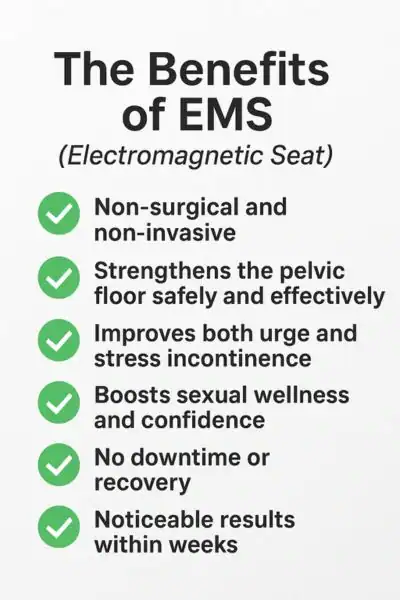Tired of Frequent Bathroom Trips? Discover How EMS (Electromagnetic Seat) Treats Urge and Stress Incontinence

Understanding the Frustration of Incontinence and frequent bathroom trips!
If you are frequently looking for the nearest bathroom, waking up at night to urinate, or anxious about leaks when laughing, sneezing, or exercising. These symptoms are common for millions of men and women and can seriously impact confidence, sleep, and daily life.
The two most common types are stress incontinence and urge incontinence, and both often result from weakened pelvic floor muscles.
The Difference Between Urge and Stress Incontinence
Understanding your symptoms helps determine the most effective treatment:
- Stress Incontinence
- Happens when coughing, sneezing, or physical movement puts pressure on the bladder, causing leaks. It’s typically due to weakened pelvic floor muscles that can no longer fully support the bladder.
- Urge Incontinence
- Causes a sudden, intense urge to urinate — sometimes followed by leakage before reaching the toilet. Sending false “full bladder” signals to the brain.
Both types are common after childbirth, menopause, prostate surgery, or simply due to ageing and loss of muscle tone.
Why the Pelvic Floor Matters To Help Avoid Frequent Bathroom Trips
Your pelvic floor muscles are a sling-like structure supporting the bladder, uterus (in women), and bowel.
When weakened, they fail to contract properly, making bladder control harder.
Strengthening these muscles is crucial for preventing leaks, but traditional Kegel exercises can be challenging to do effectively and consistently.
Introducing EMS (Electromagnetic Seat): A New Treatment To Avoid Running To The Bathroom
EMS (Electromagnetic Seat) is an advanced, non-invasive treatment that uses High-Intensity Focused Electromagnetic (HIFEM) energy to stimulate deep pelvic floor contractions — equivalent to performing over 11,000 Kegels in one 28-minute session.
You sit on the EMS (Electromagnetic Seat) while fully clothed, as it strengthens and re-educates the pelvic floor muscles. There’s no pain, downtime, or recovery required.
How EMS (Electromagnetic Seat) Treats Urge and Stress Incontinence
For Stress Incontinence:
EMS (Electromagnetic Seat) tightens and tones the pelvic floor, improving bladder support and reducing leaks triggered by physical movement.
For Urge Incontinence:
EMS (Electromagnetic Seat) retraining helps restore communication between your bladder and brain.
The electromagnetic energy restores standard neuromuscular control, reducing involuntary bladder contractions and calming overactive bladder signals — which means fewer sudden urges and fewer trips to the bathroom.
Clinical research shows that 95% of EMS (Electromagnetic Seat) patients report a significant improvement in symptoms and overall quality of life.
What to Expect During EMS (Electromagnetic Seat) Treatment
Each EMS (Electromagnetic Seat) session lasts around 30 minutes.
You’ll feel firm but comfortable muscle contractions — many describe it as a “tingling lift” sensation.
A complete course usually includes six sessions, spaced twice per week, though your treatment plan may be tailored to your needs.
There’s no downtime — you can return to work or normal activities immediately after.
The Benefits of EMS (Electromagnetic Seat)

FAQs: How EMS (Electromagnetic Seat) Treats Urge Incontinence
1. What exactly causes urge incontinence?
Urge incontinence happens when the bladder’s detrusor muscle contracts too often, creating a sudden need to urinate — even when the bladder isn’t full. It’s usually linked to nerve or muscle dysfunction in the pelvic region.
2. How does EMS (Electromagnetic Seat) stop the frequent urge to urinate?
EMS (Electromagnetic Seat) uses focused electromagnetic energy to strengthen pelvic floor muscles and retrain bladder nerves. This improves bladder control and reduces the overactive signals that cause that sudden urge.
3. How many EMS (Electromagnetic Seat) sessions are needed to improve urge incontinence?
Most clients experience significant relief after a course of six sessions over three weeks. Some notice improvement after just one or two treatments, while others benefit from maintenance sessions every few months.
4. Is EMS (Electromagnetic Seat) suitable for both men and women with urge incontinence?
Yes. EMS (Electromagnetic Seat) effectively treats both men and women, including those with post-pregnancy, menopausal, or post-prostate-surgery bladder issues.
5. When will I notice results?
Many people begin to feel improvements — such as reduced urgency and fewer bathroom trips — after their second or third session. Optimal results develop over several weeks as muscle tone and nerve communication continue to improve.
6. Does EMS (Electromagnetic Seat) help with nighttime urination (nocturia)?
Yes. By strengthening the pelvic floor and restoring bladder control, EMS (Electromagnetic Seat) can help reduce nighttime urination, allowing for deeper, uninterrupted sleep.
7. Will I still need to do pelvic floor exercises after EMS (Electromagnetic Seat)?
While EMS (Electromagnetic Seat) delivers thousands of contractions per session, maintaining a simple at-home pelvic floor routine can help sustain long-term results.
8. Is EMS (Electromagnetic Seat) safe, and does it have side effects?
EMS (Electromagnetic Seat) is FDA-cleared and clinically proven. Side effects are minimal — you may feel mild tingling or muscle soreness, similar to a workout, which quickly subsides.
9. Can EMS (Electromagnetic Seat) replace medication for urge incontinence?
In many cases, yes. EMS (Electromagnetic Seat) offers a non-drug, non-surgical alternative to traditional medications, which can have side effects. However, your practitioner will advise whether to continue or adjust your medication.
10. How long do EMS (Electromagnetic Seat) results last?
Results typically last 6–12 months. Many clients schedule maintenance sessions once or twice a year to preserve their progress.
Take Control of Your Bladder Health
If you’re tired of frequent bathroom trips or constant worry about accidents, EMS (Electromagnetic Seat) offers a safe, effective, and non-invasive way to regain control.
Say goodbye to pads and sleepless nights — and hello to confidence and freedom.
Contact Our Team today to book your EMS (Electromagnetic Seat) consultation and start your journey toward better bladder health.



